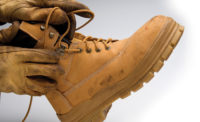The machine guarding standard, 29 Code of Federal Regulations (CFR 1910.212), always seems to make OSHA’s Top 10 Most Frequently Cited list. In 2015 it again made list, coming in at number 10. While there’s no single reason the OSHA guarding standard is so often cited by safety inspectors, a few regularly occurring issues give insight:
˜ Equipment is old, and somewhere along the way the guarding was removed, misplaced or damaged
˜ Guarding wasn’t provided as part of the original equipment
˜ There’s no previous accident history with the equipment
˜ The equipment has been officially retired, and on the rare occasion it’s used, operators are instructed to be particularly careful
Other issues include lack of proper adjustment, maintenance and training. Together, these things can spell a recipe for disaster.
OSHA’s hierarchy of hazard control
In the machine-guarding arena, applying proper engineering controls is the first line of defense and the most effective way to reduce accident risk to an acceptable level. Two types of engineering controls are: 1) designing to eliminate the hazard; and 2) installing machine guarding and devices to isolate the hazard.
The second line of defense is administrative controls, and personal protective equipment (PPE) is the final line of defense. While OSHA’s guidelines are time-tested and useful, recent advancements in machine guarding are leveraging cloud technology to help impacted organizations safely into the future.
Developing an effective program
There are essentially four basic steps to developing an effective machine guarding program:
Step One
Identify machine-guarding deficiencies for each machine by performing a thorough documented machine safety assessment and a proper documented risk assessment. Keep in mind that both OSHA and the American National Standards Institute (ANSI) have standards that frame the “why” and the “how” of the risk assessments.
OSHA’s Machinery and Machine Guarding Standard 29 CFR 1910.219 (p)(1) states: All power-transmission equipment shall be inspected at intervals not exceeding 60 days, and be kept in good working condition at all times.
ANSI’s Safety of Machinery General Requirements and Risk Assessment B11 2010: 6.9.2. offers retention guidance: The risk-assessment documentation shall be retained for the life of the machine, or as provided by an organization’s document retention policy.
It’s important that machine inspections are performed by a qualified professional who understands not only the OSHA and ANSI standards but also the other applicable National Fire Protection Association (NFPA) and International Organization for Standardization (ISO) codes that apply. A fresh set of eyes can often shed light on deficiencies that were previously overlooked “Because it’s always been like that.”
Step Two
Prioritize the machines that need guarding upgrades. Many times, inspecting hundreds or thousands of machines uncovers a number of deficiencies that are just too great to tackle all at once, and a guarding program must be approached in phases to accommodate budgets. Sorting by risk assessment scores ensures upgrades are made in a logical order of “worst first.”
Step Three
The importance of machine operator buy-in cannot be underestimated. A typical machine operator spends more time operating “their” machine than they spend interacting with their family. They know that machine inside and out, with all its quirks. That’s why it’s extremely common to get pushback when there’s any mention of adding guarding to a machine. For the operator, not knowing what to expect creates a fear of the unknown – which leads to making statements like, “This guarding thing is crazy,” “How will this affect how I work on my machine?” and, “It’s been like this for 20 years – why change it now?”
If a machine-guarding program is to be successful, it’s critical to involve the operator in the change process from the beginning – for a few reasons:
First, by explaining why a guard needs to be installed and getting the operator’s feedback from the beginning (design concept stage) to pre-production (reviewing final CAD models for any last-minute adjustments), the operator has had an opportunity to participate in the effort, and provide valuable input that gives them a comfort level with the changes and a sense of ownership over the final product.
It’s very difficult for an operator to justify giving pushback afte the fact, if they’ve been involved from the start.
Another reason Step Three is so important is that, because guarding design needs to accommodate the natural movements of the operator, it provides an opportunity to answer many questions that matter to them and you – in avoiding costly rework. Questions such as:
˜ How does the guard work?
˜ Is it a natural movement for the operator to slide or raise the guard out of the way to retrieve a piece they’re working on from the machine?
˜ If it’s repetitive, high-volume work, can the guard be automated so the operator doesn’t have to perform unnecessary, time-consuming repetitive motions?
˜ Is the guard designed to accommodate the variety of necessary machine set-ups and specialty tools that may be required to fit within it?
˜ Is the guard interlocked where necessary?
˜ Is the Estop within easy reach of the operator?
When it comes to getting operator input, remember the phrase, “Haste makes waste.” Otherwise, you may end up with an unsightly blemish on your machine-guarding program – one that can take quite a bit of time and expense to remove – especially if a guard is built and installed only to realize it has to be remade to accommodate something as simple as a specialty tool set up that hadn’t been considered in the discovery process.
Step Four
Document any and all machine-guarding improvements that have been made to a machine. While OSHA states it is the employer’s responsibility to provide a workplace free of recognized hazards (the General Duty Clause), it is the employee’s responsibility to follow the employer’s safety directives, and not remove or bypass machine guarding provided by the employer. In the event of an accident, if the employer has documented proof the machine has had the required regular, documented safety inspections and risk assessments, and provided correct and effective guarding that was disregarded or removed by operator – liability may shift.
Innovations in machine guarding
Secure, cloud-based software is one example of technology advancing comprehensive machine guarding. Such technology enables organizations to conduct, manage and store machine safety audits, risk assessments and machine information. Software can document due diligence and give safety managers a highly detailed, real-time view into their entire organization’s machine safety processes and compliance.
To help facilitate and document inspections, software can provide an extensive database of specific machine types, with pre-loaded, machine-specific inspection checklists including risk assessments. If an auditor wonders why a particular question is being asked, they can view the specific regulations and standards that pertain to that question. These ongoing, documented machine inspections will help catch machine-guarding deficiencies, and enable an organization to quickly repair or replace guards as needed.
Don’t wait
Given potential liability issues, “I didn’t know” is an inadequate answer. The good news is that with the proper processes, documentation and equipment in place, the number of machine-related accidents can be greatly reduced, if not eliminated completely – saving lives, expense, and in some cases, even your business.


